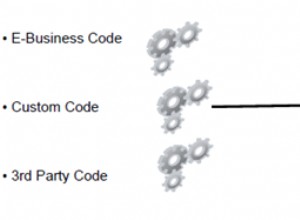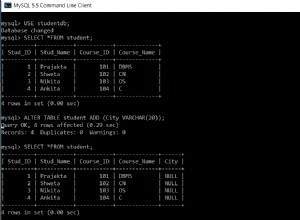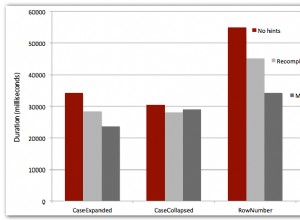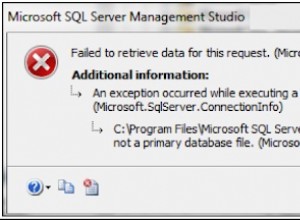Erstens, besser beim Posten dieser Frage von Ihrem anderen. Der Grund, warum Sie mehrere Datensätze erhalten haben, ist die Möglichkeit, dass eine Person je nach Schicht mehrmals am selben Tag ein- und ausstempelt. Nun, wie man das löst.
In MySQL können Sie Inline-Variablendeklarationen und -zuweisungen mit "@"-Variablen als Teil der select FROM-Klausel vornehmen. Womit ich beginne, ist eine einfache Verknüpfung vom Arbeitstag zur Schichttabelle (und glaube, ich habe das jetzt verstanden), mit einigen @Variablen.
Für jede Person, die der Schicht beigetreten ist, berechne ich im Voraus, wo die Mitte der Schicht auftritt, z. B. am selben Tag oder am nächsten Tag. Außerdem scheinen begin2 und end2 Ausreißer für ein mögliches Ein- und Ausstempeln zu sein. Beispiel:Person 1 arbeitet in Schicht 1. Schicht 1 wird für einen bestimmten Arbeitstag als
definiertshiftcode shiftbegin2 shiftbegin shiftmid shiftend shiftend2
1 04:00:00 08:00:00 12:00:00 17:30:00 21:30:00
Ich interpretiere das also so, als ob ich am 28. Juni, Schicht 1, arbeite
June 28 @ 4am Earliest allowed clock-in time
June 28 @ 8am Actual beginning of shift
June 28 @ 12pm (afternoon) is the middle of the work day
June 28 @ 5:30pm is the end of the work day
June 28 @ 9:30pm is the max expected clock-out recognized for the shift
Ebenso für Schicht 2, die eine Übernachtung einschließt
shiftcode shiftbegin2 shiftbegin shiftmid shiftend shiftend2
2 12:00:00 17:30:00 21:00:00 05:30:00 09:30:00
June 28 @ 12pm (afternoon) Earliest allowed clock-in time
June 28 @ 5:30pm Actual beginning of shift
June 28 @ 9pm is the middle of the shift
June 29 @ 5:30am (day roll-over) is the end of the work day
June 29 @ 9:30am (day roll-over) is the max expected clock-out for the shift
Also, wenn das alles richtig ist, bestimmt meine innere Frage all diese Bereiche für jede Person im Voraus, sodass ich immer nur 1 Datensatz pro Person und Arbeitstag haben werde, unabhängig davon, wie viele Scans über unten stehen.
select
wd.wdpercode,
wd.wdshift,
wd.wddate,
s.shiftbegin,
s.shiftend,
s.shiftbegin2,
s.shiftmid,
s.shiftend2,
@midDay := if( s.shiftbegin < s.shiftmid, wd.wddate, date_add( wd.wddate, interval 1 day )) as NewMidDay,
@endDay := if( s.shiftbegin < s.shiftend, wd.wddate, date_add( wd.wddate, interval 1 day )) as NewEndDay,
cast( concat(wd.wddate, ' ', s.shiftbegin2 ) as DateTime ) as EarliestClockIn,
cast( concat(wd.wddate, ' ', s.shiftbegin ) as DateTime ) as BeginShift,
cast( concat(@midDay, ' ', s.shiftmid ) as DateTime ) as MidShift,
cast( concat( @endDay, ' ', s.shiftend ) as DateTime ) as EndShift,
cast( concat( @endDay, ' ', s.shiftend2 ) as DateTime ) as MaxClockOut
from
( select
@endDay := '',
@midDay := '' ) sqlvars,
tb_workday wd
join tb_shift s
on wd.wdshift = s.shiftcode
Die Inline-Berechnung von @midDay und @endDay ist so, dass ich mir keine Gedanken über den Beitritt zur gescannten Uhrzeittabelle machen muss und ständig 1 Tag inmitten aller anderen Überlegungen hinzufüge. Am Ende dieser Abfrage würde ich also so etwas wie ... Mitteilung zwischen Person 1 Normalschicht und Person 2 Nachtschicht, das berechnete Enddatum zeigt auch die Rollover-Daten
wdpercode wdshift wddate shiftbegin shiftend shiftbegin2 shiftmid shiftend2 NewMidDay NewEndDay EarliestClockIn BeginShift MidShift EndShift MaxClockOut
000001 1 2010-10-10 08:00 17:30 04:00 12:00 21:30 2010-10-10 2010-10-10 2010-10-10 04:00 2010-10-10 08:00 2010-10-10 12:00 2010-10-10 17:30 2010-10-10 21:30:00
000001 1 2010-10-11 08:00 17:30 04:00 12:00 21:30 2010-10-11 2010-10-11 2010-10-11 04:00 2010-10-11 08:00 2010-10-11 12:00 2010-10-11 17:30 2010-10-11 21:30:00
000001 1 2010-10-12 08:00 17:30 04:00 12:00 21:30 2010-10-12 2010-10-12 2010-10-12 04:00 2010-10-12 08:00 2010-10-12 12:00 2010-10-12 17:30 2010-10-12 21:30:00
000001 1 2010-10-13 08:00 17:30 04:00 12:00 21:30 2010-10-13 2010-10-13 2010-10-13 04:00 2010-10-13 08:00 2010-10-13 12:00 2010-10-13 17:30 2010-10-13 21:30:00
000002 2 2010-10-10 17:30 05:30 12:00 21:00 09:30 2010-10-10 2010-10-11 2010-10-10 12:00 2010-10-10 17:30 2010-10-10 21:00 2010-10-11 05:30 2010-10-11 09:30:00
000002 2 2010-10-11 17:30 05:30 12:00 21:00 09:30 2010-10-11 2010-10-12 2010-10-11 12:00 2010-10-11 17:30 2010-10-11 21:00 2010-10-12 05:30 2010-10-12 09:30:00
000002 2 2010-10-12 17:30 05:30 12:00 21:00 09:30 2010-10-12 2010-10-13 2010-10-12 12:00 2010-10-12 17:30 2010-10-12 21:00 2010-10-13 05:30 2010-10-13 09:30:00
000002 2 2010-10-13 17:30 05:30 12:00 21:00 09:30 2010-10-13 2010-10-14 2010-10-13 12:00 2010-10-13 17:30 2010-10-13 21:00 2010-10-14 05:30 2010-10-14 09:30:00
Sie könnten die zusätzlichen Spalten aus dieser Abfrage entfernen, aber ich habe alle eingefügt, damit Sie sehen / bestätigen können, welche Werte für die Berücksichtigung jeder Zeile und des geplanten Arbeitsdatums gelten. Die abgekürzte Liste, die ich noch brauchen würde, ist
select
wd.wdpercode,
@midDay := if( s.shiftbegin < s.shiftmid, wd.wddate, date_add( wd.wddate, interval 1 day )) as NewMidDay,
@endDay := if( s.shiftbegin < s.shiftend, wd.wddate, date_add( wd.wddate, interval 1 day )) as NewEndDay,
cast( concat(wd.wddate, ' ', s.shiftbegin2 ) as DateTime ) as EarliestClockIn,
cast( concat(wd.wddate, ' ', s.shiftbegin ) as DateTime ) as BeginShift,
cast( concat(@midDay, ' ', s.shiftmid ) as DateTime ) as MidShift,
cast( concat( @endDay, ' ', s.shiftend ) as DateTime ) as EndShift,
cast( concat( @endDay, ' ', s.shiftend2 ) as DateTime ) as MaxClockOut
Also, wenn das Obige richtig ist, müssen wir jetzt die Uhr für jede Person auf der Grundlage des MAXIMAL-Bereichs, der aus dieser Abfrage berechnet wurde, ein- und ausschalten, was mehr als ein Datensatz pro Datum sein KÖNNTE
wdpercode EarliestClockIn MidShift MaxClockOut
000001 2010-10-10 04:00 2010-10-10 12:00 2010-10-10 21:30:00
000002 2010-10-10 12:00 2010-10-10 21:00 2010-10-11 09:30:00
Hier mache ich also eine Verbindung zu den Scanzeiten für alle Daten innerhalb des frühesten Ein- und Ausstempelns und verwende die Mitte der Schicht als Grundlage für die Bestimmung, ob sie spät eingestempelt oder früh gegangen sind. Ich habe die zusätzlichen MIN() und MAX() für die Ankunft und Abreise für eine bestimmte Person / Schicht hinzugefügt, nur um zu bestätigen, was Sie TUN UND sehen sollten.
Der Zweck von MAX( IF() ) besteht darin, den späten/frühen Status NUR WENN sie eingetreten sind, zu erfassen. Da das Gruppieren pro Schicht erfolgt, ist der erste Datensatz (Kommen) möglicherweise zu spät und Sie möchten diese Zeit, aber der zweite Datensatz zum Ausstempeln ist nicht über die Schichtmitte anwendbar und wäre daher leer. Ebenso zum Erkennen eines vorzeitigen Verlassens einer Schicht.
select
perPerson.wdPerCode,
perPerson.BeginShift,
perPerson.EndShift,
min( TS.scScanTime ) as Arrival,
max( TS.scScanTime ) as Departure,
max( IF( TS.scScanTime > perPerson.BeginShift
AND TS.scScanTime <= perPerson.MidShift, TS.scScanTime, "" )) as LateArrival,
max( IF( TS.scScanTime > perPerson.MidShift
AND TS.scScanTime < perPerson.EndShift, TS.scScanTime, "" )) as EarlyDepart
from
( select
wd.wdpercode,
@midDay := if( s.shiftbegin < s.shiftmid, wd.wddate,
date_add( wd.wddate, interval 1 day )) as NewMidDay,
@endDay := if( s.shiftbegin < s.shiftend, wd.wddate,
date_add( wd.wddate, interval 1 day )) as NewEndDay,
cast( concat(wd.wddate, ' ', s.shiftbegin2 ) as DateTime ) as EarliestClockIn,
cast( concat(wd.wddate, ' ', s.shiftbegin ) as DateTime ) as BeginShift,
cast( concat(@midDay, ' ', s.shiftmid ) as DateTime ) as MidShift,
cast( concat( @endDay, ' ', s.shiftend ) as DateTime ) as EndShift,
cast( concat( @endDay, ' ', s.shiftend2 ) as DateTime ) as MaxClockOut
from
( select
@endDay := '',
@midDay := '' ) sqlvars,
tb_workday wd
join tb_shift s
on wd.wdshift = s.shiftcode ) perPerson
JOIN tb_scan TS
on perPerson.wdpercode = TS.scpercode
AND TS.scScanTime >= perPerson.EarliestClockIn
AND TS.scScanTime <= perPerson.MaxClockOut
group by
perPerson.wdPerCode,
perPerson.BeginShift;
Ich habe Tabellen und Beispieldaten aus dem erstellt, was Sie über bereitgestellt haben (einige Ihrer Daten stimmten nicht mit den Beispieldaten und -bereichen überein, daher habe ich dies angepasst).
CREATE TABLE `tb_scan` (
`scpercode` varchar(6) DEFAULT NULL,
`scscantime` datetime,
KEY `all` (`scyear`,`scmonth`,`scday`)
) ENGINE=MyISAM DEFAULT CHARSET=latin1;
insert into tb_scan
( scpercode, scscantime )
values
( '000001', '2010-10-10 08:02:00' ),
( '000001', '2010-10-10 17:33:00' ),
( '000001', '2010-10-11 07:48:00' ),
( '000001', '2010-10-11 17:29:00' ),
( '000001', '2010-10-12 08:04:00' ),
( '000001', '2010-10-12 17:28:00' ),
( '000002', '2010-10-10 17:31:00' ),
( '000002', '2010-10-11 05:35:00' ),
( '000002', '2010-10-11 17:28:00' ),
( '000002', '2010-10-12 05:29:00' ),
( '000002', '2010-10-12 17:32:00' ),
( '000002', '2010-10-13 05:27:00' );
CREATE TABLE `tb_workday` (
`wdpercode` varchar(6) DEFAULT NULL,
`wdshift` varchar(1) DEFAULT NULL,
`wddate` date DEFAULT NULL
) ENGINE=MyISAM DEFAULT CHARSET=latin1;
insert into tb_workday
( wdpercode, wdshift, wddate )
values
( '000001', '1', '2010-10-10' ),
( '000001', '1', '2010-10-11' ),
( '000001', '1', '2010-10-12' ),
( '000001', '1', '2010-10-13' ),
( '000002', '2', '2010-10-10' ),
( '000002', '2', '2010-10-11' ),
( '000002', '2', '2010-10-12' ),
( '000002', '2', '2010-10-13' );
CREATE TABLE `tb_shift` (
`shiftcode` varchar(1) DEFAULT NULL,
`shiftbegin2` varchar(8) DEFAULT NULL,
`shiftbegin` varchar(8) DEFAULT NULL,
`shiftmid` varchar(8) DEFAULT NULL,
`shiftend` varchar(8) DEFAULT NULL,
`shiftend2` varchar(8) DEFAULT NULL
) ENGINE=MyISAM DEFAULT CHARSET=latin1;
insert into tb_shift
( shiftcode, shiftbegin2, shiftbegin, shiftmid, shiftend, shiftend2 )
values
( '1', '04:00:00', '08:00:00', '12:00:00', '17:30:00', '21:30:00' ),
( '2', '12:00:00', '17:30:00', '21:00:00', '05:30:00', '09:30:00' );
Die Beispieldaten zeigen jede Person mit 1:spät ankommen, 2:früh abreisen, 3:spät ankommen UND früh abreisen.
wdPerCode BeginShift EndShift Arrival Departure LateArrival EarlyDepart
000001 2010-10-10 08:00 2010-10-10 17:30 2010-10-10 08:02 2010-10-10 17:33 2010-10-10 08:02
000001 2010-10-11 08:00 2010-10-11 17:30 2010-10-11 07:48 2010-10-11 17:29 2010-10-11 17:29
000001 2010-10-12 08:00 2010-10-12 17:30 2010-10-12 08:04 2010-10-12 17:28 2010-10-12 08:04 2010-10-12 17:28
000002 2010-10-10 17:30 2010-10-11 05:30 2010-10-10 17:31 2010-10-11 05:35 2010-10-10 17:31
000002 2010-10-11 17:30 2010-10-12 05:30 2010-10-11 17:28 2010-10-12 05:29 2010-10-12 05:29
000002 2010-10-12 17:30 2010-10-13 05:30 2010-10-12 17:32 2010-10-13 05:27 2010-10-12 17:32 2010-10-13 05:27
Zur Optimierung der Abfrage würde ich Ihren Index in der Scan-Tabelle ändern
CREATE TABLE `tb_scan` (
`scpercode` varchar(6) DEFAULT NULL,
`scscantime` datetime,
KEY `personDate` (`scpercode`, `scscantime` )




